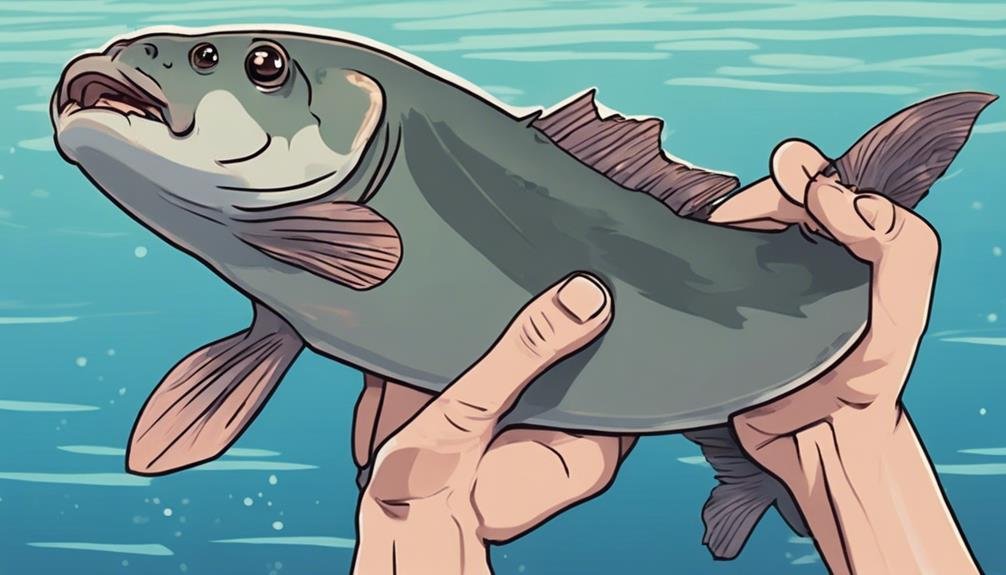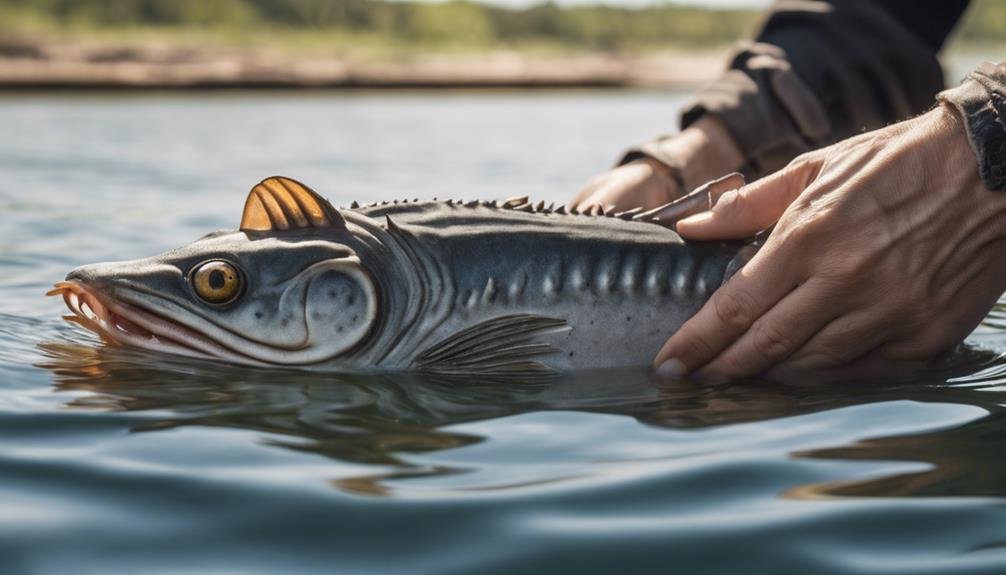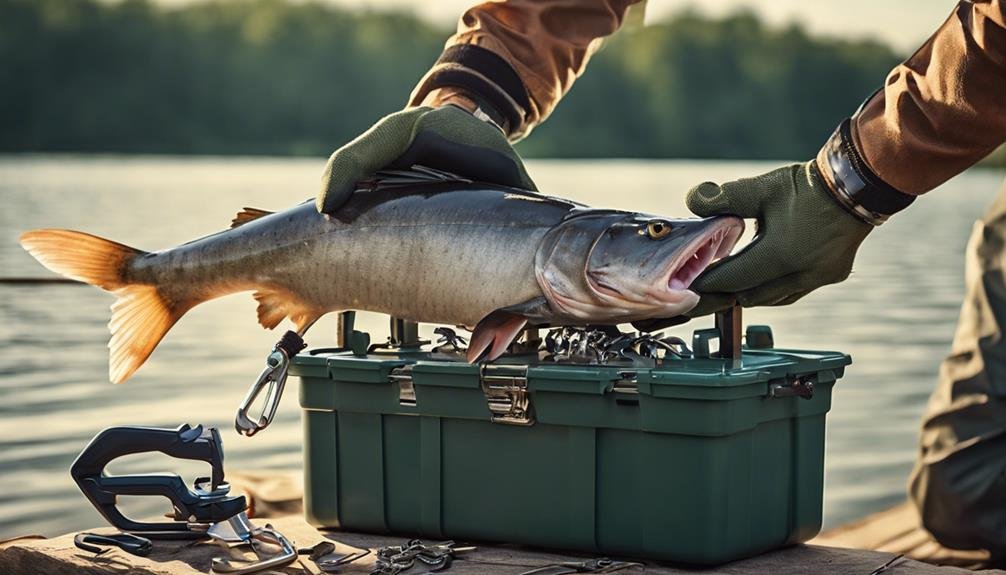When you catch a catfish, your first thought should be how to hold it safely. Placing your hand behind its pectoral fins would be best to avoid those venomous spines. Getting a firm grip by wrapping your fingers around the backside is essential, but there’s more to it than just the grip. Lifting the catfish gently and evenly is key, but what about the spines on the dorsal fin? Keeping your hands safely positioned is crucial, but how do you guarantee you stay sting-free? Let’s explore the techniques to make your catfish handling safe and efficient.
Key Takeaways
- Place your hand behind the catfish’s pectoral fins to avoid venomous spines.
- Secure your grip by wrapping your fingers around the backside of the catfish.
- Keep your fingers away from the front of the fins to prevent accidental spinning.
- Lift the catfish gently and evenly to avoid slipping or injury.
- Use a lip grip tool for additional support and safe handling.
Proper Hand Placement

When holding a catfish, placing your hand just behind the pectoral fins is vital to avoid the venomous spines. You’ll want to secure your grip by wrapping your fingers around the backside of the catfish. This means positioning your thumb and forefinger on either side of the fish, just behind the pectoral fins. By doing this, you avoid dangerous spines and maintain a firm and safe hold.
Keep your fingers away from the front of the fins to prevent accidental spinning. The spines can cause painful injuries, so correct hand placement is important. Lift the catfish gently and evenly to avoid slipping or injury. A gentle but firm hold helps you control the fish without causing it stress or harm.
Adjust your hand positioning to maintain a safe and firm hold on the catfish. Sometimes, the fish might wiggle, requiring you to reposition your grip.
Always keep your hand behind the pectoral fins, with your thumb and forefinger securely wrapped around the fish’s body. This method ensures both your safety and the catfish’s well-being.
Avoiding Catfish Spines
To avoid catfish spines, always start by being mindful of their location. Catfish have venomous spines on their dorsal and pectoral fins. These spines contain a non-lethal toxin that can cause significant discomfort. When handling catfish, keep your hands positioned behind these spines. This helps you evade injury.
Wrap your hand around the catfish’s backside, ensuring your fingers don’t run over the spines accidentally. Maintaining a firm grip is essential to prevent getting poked. Remember, the dorsal spine is on the top, and the pectoral fins are on the sides. Here’s a quick reference table to help you recall:
| Spine Location | Position on Catfish |
|---|---|
| Dorsal Spine | Top |
| Left Pectoral Fin | Side (left) |
| Right Pectoral Fin | Side (right) |
| Safe Hand Position | Behind the Spines |
| Grip Type | Firm but Gentle |
When releasing a catfish, lower it close to the water surface and let it slip beneath to swim away safely. This reduces the risk of getting poked by the spines during release. Always use caution and focus on proper hand positioning to guarantee a safe and pleasant experience while handling catfish.
Lifting Techniques

Lifting a catfish correctly is important for your safety and the fish’s well-being. To avoid catfish stings, begin by locating the fin spines. These spines are found on the dorsal and pectoral fins, and knowing their location is vital. You might be nervous for the first time but follow these steps carefully.
Wrap your hand around the backside of the catfish, maintaining a secure grip. Place your fingers on either side of the pectoral fins. This technique helps you maintain control and prevents the fish from wriggling free.
Lift the catfish gently with equal pressure to minimize stress on the fish. A gentle lift ensures that the fish remains calm, reducing the risk of injury to you and the catfish.
If you need additional support, you can use a lip grip. However, be cautious and make sure it doesn’t harm the fish. Alternatively, you can grab the catfish from underneath, but always be mindful of those sharp spines.
Safe Catfish Release
After mastering the correct lifting techniques, it’s essential to focus on safely releasing the catfish. First, lower the catfish near the water’s edge to release it gently. This minimizes stress on the fish and helps avoid injuries. Always make sure your fingers are behind the spines of the pectoral fins and dorsal fins to prevent any harm to yourself.
When releasing smaller catfish, it’s vital to be gentle. Please don’t throw the catfish forcefully; slide it beneath the water’s surface. This allows the fish to swim away freely and quickly and guarantees that the affected area of the catfish isn’t harmed during the release process.
While releasing the catfish, maintain a safe distance from the water. This reduces the risk of slipping or falling into the water.
Here’s a quick reference table to guide you through the process:
| Step | Action | Purpose |
|---|---|---|
| 1. Lowering | Close to the water’s edge | Minimize stress on fish |
| 2. Finger Position | Behind pectoral and dorsal fins | Prevent personal injury |
| 3. Gentle Release | Slide beneath the water’s surface | Allow fish to swim freely |
| 4. Safety | Maintain a safe distance from water | Reduce the risk of falling |
Handling Equipment

When you’re gearing up to handle catfish, having the right equipment can make all the difference. Make sure you invest in rugged outdoor gloves. These gloves are essential when holding a catfish, especially a channel catfish, because their spines can be quite sharp. While thicker gloves might reduce your sensitivity, they’ll provide much better protection against those potentially painful spines.
Additionally, consider using lip grip tools. These handy devices securely hook onto the fish’s lip, allowing you to handle the catfish safely and with more control. They’re soft on the fish, minimizing stress and injury to the animal.
Remember to bring along tweezers. If you get pricked by a spine, tweezers can help you remove any pieces lodged in your skin. Combine this with an antiseptic spray and hydrocortisone medication to treat injuries promptly.
Conclusion
By properly placing your hand behind its pectoral fins and avoiding the venomous spines, you can safely hold a catfish. Lift it gently and evenly, ensuring your grip is secure. Always stay aware of the spines on the dorsal and pectoral fins. When it’s time to release the catfish, handle it carefully to avoid harm to both you and the fish. With these techniques, you’ll confidently and safely manage your catfish catch.
FAQs
How do you safely hold a catfish?
To safely hold a catfish without getting injured by its spines, follow these steps:
- Small Catfish (Under 5 lbs):
- Place your hand behind the pectoral and dorsal fins, as these fins contain sharp spines that can puncture the skin.
- Position your thumb under the catfish’s belly and your fingers on top, applying gentle pressure to control the fish.
- Large Catfish (Over 5 lbs):
- For larger catfish, avoid grabbing near the fins. Instead, hold them by the lower jaw with a firm grip, ensuring your fingers avoid the sharp spines.
- Use a fish gripper or glove to improve your grip and prevent injury.
Key Tips:
- Always grip the fish behind the spines for small catfish.
- Hold large catfish by the lower jaw to avoid spines.
Why do you need to be careful when holding a catfish?
Catfish have sharp pectoral and dorsal fin spines that can cause painful punctures or injuries if you hold them improperly. These spines are used for defense and can easily pierce through skin. Handling the fish properly helps avoid injury to both you and the fish.
Reasons for Caution:
- Sharp spines on the pectoral and dorsal fins.
- Incorrect handling can lead to painful punctures.
What tools can help when holding a catfish?
Several tools can help you handle catfish more safely and effectively:
- Fish Grippers are useful for gripping larger catfish by the lower jaw.
- Fishing Gloves: Provides better grip and protects your hands from the catfish’s spines.
- Pliers: Use pliers to remove hooks from the catfish’s mouth without risking injury from the spines.
Helpful Tools:
- Fish grippers for large catfish.
- Gloves to protect hands.
- Pliers for hook removal.

